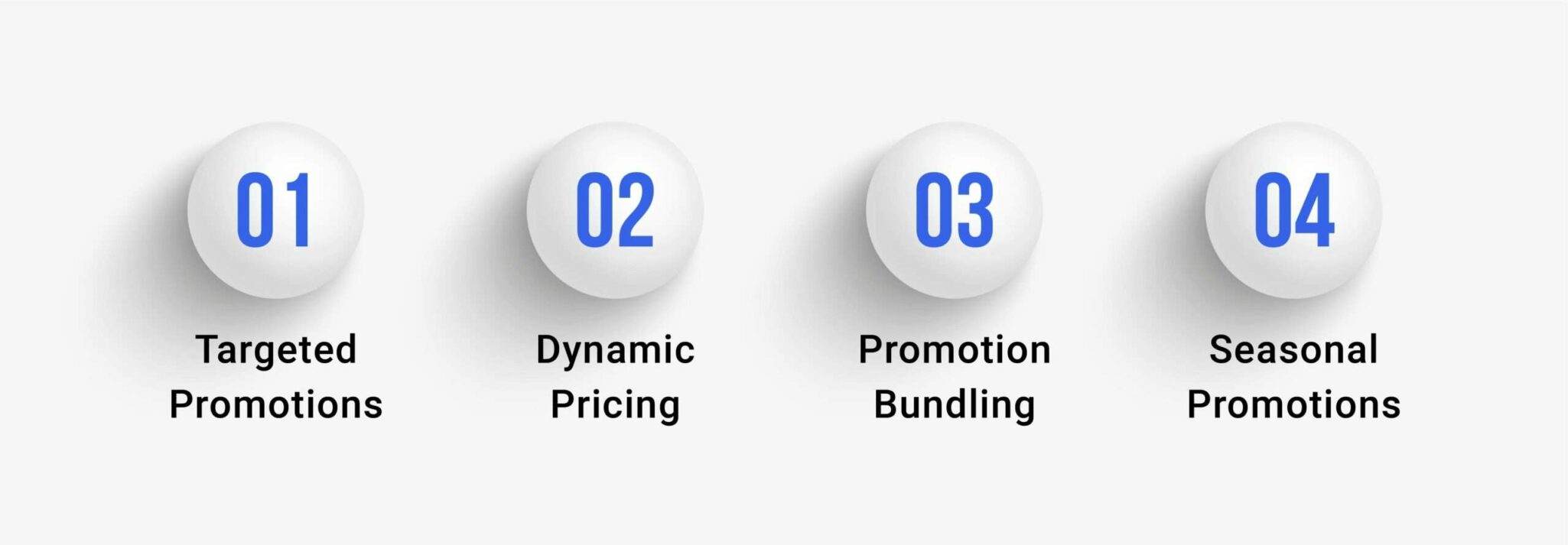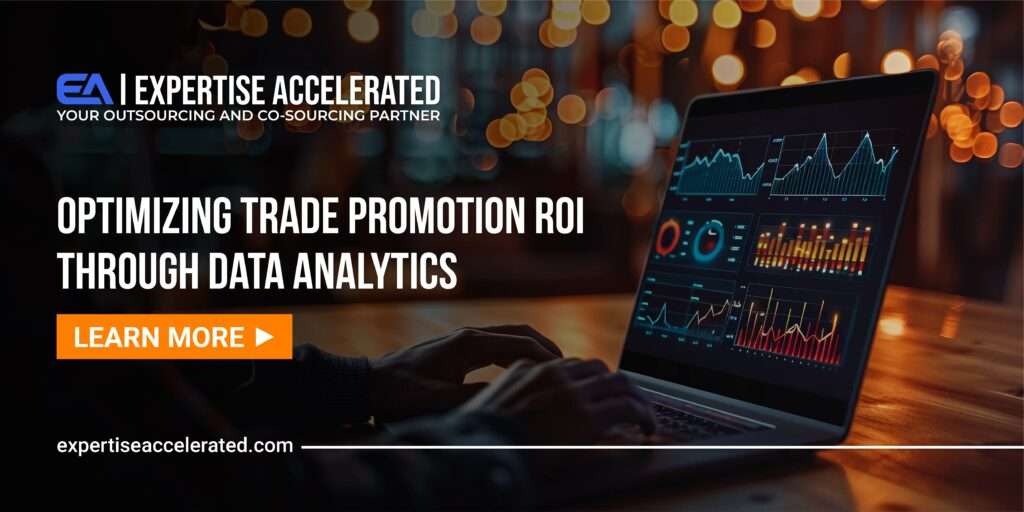Increasing costs and tough competition leaving your Trade Promotion Management ineffective? Discover data-driven solutions to boost ROI and conquer market challenges.
In the dynamic landscape of consumer packaged goods (CPG), trade promotion is a pivotal strategy for driving sales and enhancing brand visibility. However, amidst the ever-evolving market dynamics, traditional approaches to trade promotions often fail to deliver the desired return on investment (ROI). This is where data analytics can lend a helping hand.
In this blog post, we discuss:
– How businesses can optimize their trade promotions by integrating data analytics.
-How can using data analytics for TPO also positively impact long-term financial performance.
-Why it’s high time to tap into the power of data and start our journey toward maximizing trade promotion ROI!
-And we reveal how Expertise Accelerated can help companies bring about synchronization and congruity among the underlying complex variables that define the success of TPM campaigns.
Understanding Trade Promotion Optimization (TPO)
Trade Promotion Optimization (TPO) represents a strategic shift from traditional ‘spray and pray’ methods to data-driven precision. It involves the strategic analysis, planning, execution, and evaluation of promotional activities backed by comprehensive data analytics.
Trade Promotion Management Vs. Trade Promotion Optimization
Trade promotion optimization is different from trade promotion management (TPM). TPM relates to the practical implementation of planned promos. It involves operational activities, logistics and budgeting among many other activities.
On the other hand, TPO refers to the planning of future promo activities based on the relevant historical data. The same personnel can carry out both the processes but it is important to distinguish between the two. TPO utilizes diverse data sets derived from historical sales data, market trends, consumer behavior and competitive analysis to predict outcomes and optimize spending.
By embracing TPO, businesses can ensure that promotions are not just costs but powerful investments toward enhanced visibility and profitability.
Challenges Addressed by TPO
Traditional trade promotions often lacked precision, relying on intuition rather than insights. Common issues included misalignment with market trends, poor inventory management, and a diluted ROI.
Data-driven TPO tackles these challenges head-on by minimizing guesswork, aligning promotions with consumer behavior, and maximizing ROI.
Learn more about handling challenges in TPM for small businesses here.
The Role of Analytics in TPO
Analytics lies at the heart of TPO, enabling businesses to dissect massive data sets, identify patterns, and predict outcomes accurately.
For instance, businesses can gain valuable insights into sales trends, consumer behavior, and market dynamics which can help them develop promotional strategies that are more aligned with consumers’ needs.
Data analytics can help such companies anticipate the results of their promotions in real-time. Based on real-time data, it is also common for companies to adjust their strategies if their promotions aren’t generating results as anticipated based on real-time data. For example, companies can quickly identify underperforming promotions and make data-driven adjustments as needed.
Examples of Trade Promotion Optimization (TPO) Strategies in Retail Companies:

1- Targeted Promotions:
Retail brands can use customer segmentation analysis to identify high-value customer segments and tailor promotions to meet their specific needs and preferences. For example, they offer personalized discounts or loyalty rewards to incentivize repeat purchases from loyal customers.
2- Dynamic Pricing
Leveraging competitor pricing data and market demand forecasts, firms can implement dynamic pricing strategies to adjust prices in real time based on changing market conditions. For instance, they offer time-sensitive discounts or flash sales to capitalize on demand spikes.
3- Promotion Bundling
Analyzing historical sales data and customer purchasing patterns, we can identify complementary products that can be bundled together in promotional offers. For example, companies can offer discounts on products purchased together, such as chips and salsa or shampoo and conditioner.
4- Seasonal Promotions
Anticipating seasonal trends and consumer preferences, many retail companies across the US, design promotions tailored to seasonal holidays, events, or trends. For instance, they offer special promotions on grilling supplies in the summer or holiday-themed discounts during the festive season.
Through data analytics, companies can explore a range of promotion scenarios, evaluate effectiveness, and optimize spending. Key metrics such as lift, incremental sales, event spend, cost per incremental dollar, and ROI provide valuable insights for refining promotional strategies.
Insights from Walmart’s Aggressive Pricing Strategy

In the US retail sector, particularly in the context of trade promotion optimization, Walmart’s strategy and its impact on the grocery industry provide valuable insights:
Market Dominance and Customer Acquisition
Walmart’s substantial market share in the grocery sector (nearly a quarter of the US annual grocery spend) positions it as a key player. Even after experiencing revenue growth and widening margins, it’s strategy to lower prices indicates a deliberate effort to further solidify its market dominance.
Moreover, the significant rise in e-commerce sales, particularly from higher-income customers, underscores the effectiveness of Walmart’s approach in retaining and attracting diverse customer segments.
Impact on Competitors and Market Dynamics
The price war initiated by Walmart extends beyond seasonal promotions, signaling a shift in industry dynamics. Competitors like Kroger and Albertsons have faced challenges in retaining market share amidst Walmart’s aggressive pricing strategy.
Similarly, Target’s attempt to cut prices on food and essential items reflects a reactive measure, highlighting the pressure competitors face to respond to Walmart’s market moves.
Consumer Behavior and Industry Trends
The evolving consumer behavior towards practicality and price-consciousness at every income level shapes industry trends. Companies like Costco and Aldi, known for their low-price offerings, have experienced growth and gained market share in 2024. This trend underscores the importance of aligning trade promotion strategies with changing consumer preferences and market dynamics.
Implementing TPO Solutions
Successfully implementing TPO solutions involves several key steps. Businesses must identify their objectives for optimizing trade promotion and assess their data sources.
Evaluating TPO analytics solutions that seamlessly integrate with existing data sources and offer advanced capabilities is crucial. Comprehensive training and ongoing monitoring ensure effective utilization of TPO solutions, driving continuous optimization and maximizing ROI.
Future Trends in TPO
Looking ahead, TPO is poised to become even more sophisticated with emerging technologies like AI and machine learning taking the lead. These advancements promise to transform trade promotions into predictive and adaptive strategies that dynamically align with changing market conditions.
Integration of IoT for inventory management, blockchain for data security, and advanced AI models for predictive analytics are among the future trends shaping TPO.
Conclusion
Optimizing trade promotion ROI is essential for sustainable growth in today’s competitive CPG landscape. Data analytics, offers a transformative solution particularly through Trade Promotion Optimization (TPO). Businesses can fine-tune their promotional strategies by leveraging data-driven insights, drive efficiency, and achieve meaningful results.
After all, companies that effectively manage pricing strategies, and customer acquisition, and adapt to evolving consumer expectations are likely to thrive in the competitive market environment.
Embracing TPO represents a strategic imperative for businesses aiming to thrive in the evolving retail environment. The future of trade promotion optimization is data-driven, and for those ready to embark on this journey, the possibilities are limitless.
As global markets face increasing turbulence, with rising input costs and squeezed margins, consumer goods (CG) companies find themselves engaged in an intensified battle for competitive advantage. Consequently, the strategic and tactical importance of Trade Promotion Management (TPM) becomes ever more pronounced.
Leverage Expertise Accelerated global talent pool to provide you with offshore resources that can fill in the capacity gap and shield your TPM campaigns against poor ROIs.


